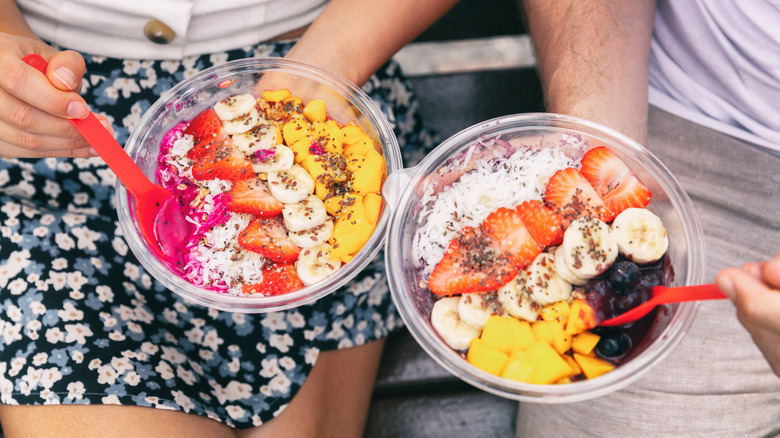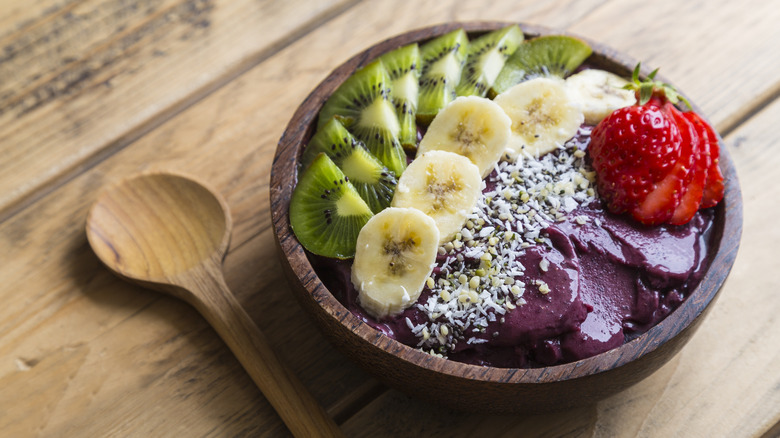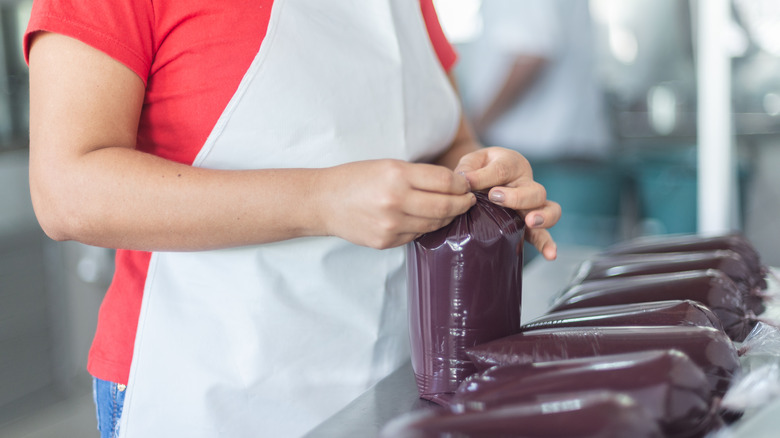What Actually Goes Into An Açaí Bowl?
We may receive a commission on purchases made from links.
When a morning smoothie isn't enough to satisfy your cravings for fresh fruit, an açaí bowl — pronounced "ah-sai-ee," for those afraid to ask — is a perfect souped-up alternative. The breakfast-appropriate food has been a favorite in the U.S. since the early 2000s and hasn't yet shown signs of falling from grace.
What differentiates it from a smoothie poured into a bowl and scattered with toppings? The answer's in the name. The açaí berry, a so-called superfood that grows on a palm tree native to the Brazilian Amazon, serves as the vibrant purple base of the layered dish. Its tart, earthy flavor is usually tempered by other fresh or frozen fruits, blended into a consistency thicker than a smoothie.
Of course, it wouldn't be an açaí bowl without the toppings. Fresh berries and sliced fruit such as strawberries, bananas, and mango might be flanked by any number of nutritious add-ins, from nuts and seeds to coconut flakes. If you're buying your acai bowl at a chain, you'll often get to choose your own toppings. For instance, Frutta Bowls' build-your-own-bowl option includes one of two granolas, three fruits, and two extra toppings, such as cacao nibs and hemp seeds.
Fuel for surfers and jiujitsu stars
Açaí berries have long been a staple in Brazil, specifically among the Oiapoque indigenous people, who've been eating them (and using them for medicinal purposes) for centuries. Around Pará and other northern areas of the country, the berry even finds its way into savory applications. Without added sugar or additional fruit, the earthy acidity of açaí plays well alongside fried fish, a common meal that treats the berry as a cold soup or dip topped with manioc starch or dried tapioca pearls.
Meanwhile, açaí bowls as we know them in the U.S. are relatively new. The idea is credited to the Brazilian jiujitsu stars Hélio and Carlos Gracie, who grew up in Pará. At their training facility in Rio de Janeiro in the 1980s, the brothers treated their students to frozen açaí pulp with sweet guaraná syrup, topped with fresh fruit and granola, as part of the self-proclaimed "Gracie Diet." Thanks to its energy-boosting properties and sweet, refreshing taste, it wasn't long before the bowls got the attention of Brazilians outside the world of jiujitsu. Surfers and other health-minded individuals caught on a couple of decades later in the U.S., giving way to what has proven to be more than a trend.
Yay for puree
You won't find fresh açaí berries in American supermarkets — or any supermarkets outside Brazil, for that matter. Since they're difficult to grow outside their native environment and are highly perishable, the berries are pitted, pulped, and processed into puree before being shipped abroad. If you feel like making an açaí bowl at home, buying the berries pre-pulped takes away the work of straining it yourself.
To prepare your base, thaw the puree overnight in the fridge or, if pressed for time, in a bowl of room-temperature water. Then, empty the packet into a blender with additional fruits of your choice, plus a splash of milk or fruit juice to loosen things up. Top with the usual smattering of accouterments and grab a spoon, or add more liquid to turn it into a drinkable smoothie. Don't be surprised if you experience a jolt of energy from this berry that inspires you to learn jiujitsu.


